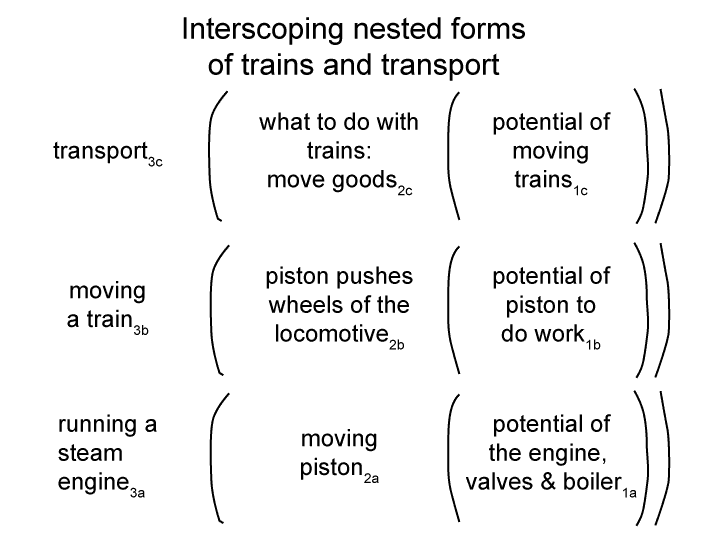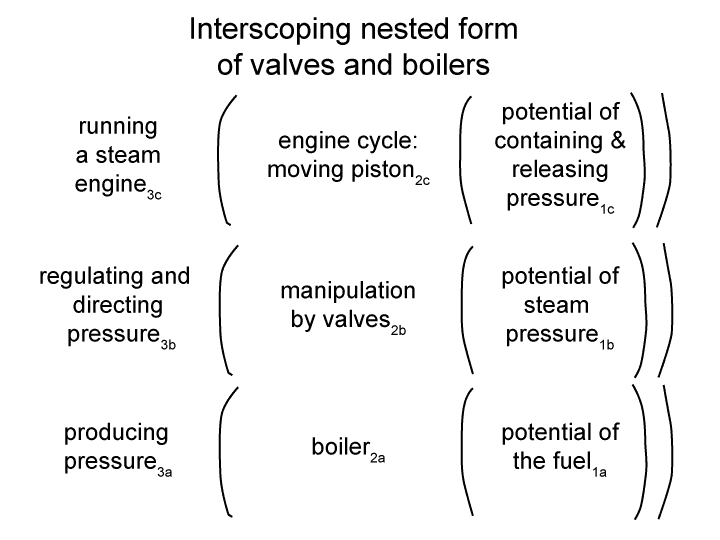Man and Sin by Piet Schoonenberg (1964) 2.3 F
Summary of text [comment] page 80
[The piston of the steam engine could accomplish work.
What type of work?
‘Work’ has a technical definition in physics. Here, I mean ‘getting a task accomplished’ in contrast to ‘wasting effort’.
This goes with the perspective level of a steam engine.
The perspective level of the piston may interscope with higher nested forms.
The result is another interscope.]
Man and Sin by Piet Schoonenberg (1964) 2.3 D
Summary of text [comment] page 80
[For those trained in psychoanalysis, please do not blow a gasket.
I am only letting off a little steam.
After all, valves and boilers function like Freud’s ‘unconscious’. But, they know not what they do.
Three interscoping forms describe an engine that powers a locomotive.
On the content level, steam is produced. The ancient Greeks had a toy that spun from the emission of steam. They never thought to turn it into an engine. The mechanical philosophers of the West did, around 2000 years later.
They did so by altering the steam’s situation. The pressure of the steam could force a piston to move. Valves were necessary to do this. One valve opened to let water in. That valve shut and the piston moved from volume produced by steam. Then another valve opened to release the steam.
The valves, then, operated in the normal context of ‘moving a piston’. The moving piston then could be used for work.]
Man and Sin by Piet Schoonenberg (1964) 2.3 C-2
[How about this metaphor?
The person’s psyche is like a steam engine.
Perhaps, the normal contexts of think and law act like regulators. Conscience and dispositions act like fuel.
Sigmund Freud, one of the founders of psychoanalysis, started with a picture of the unconscious as a steam engine powering a locomotive.
Freud wrote between 1890 and 1950 AD (7690-7750 U0′).]
Man and Sin by Piet Schoonenberg (1964) 2.3 C-1
Summary of text [comment] page 80
[This raises the question: Do the models built of interscoping and intersecting nested forms apply to the development of the hardened heart?
Hmmm.
Come to think of it, most other models of the hardened heart are metaphors.
So do the models built of interscoping and intersecting nested forms apply to these metaphors?]
Man and Sin by Piet Schoonenberg (1964) 2.3 B
Summary of text [comment] page 80
The inclination to evil is a sequel to sin. The human (who was not undergone an interior conversion under the influence of grace) will always be self-centered and selfish. These will guide his first actions. These actions will have consequences. The person will look for some way out. His heart will then harden into pride and despair.
Man and Sin by Piet Schoonenberg (1964) 2.3 A-2
[How does the term, our powerlessness for the good, summarize the previous discussion on the sequels to sin?
Our inability to love is a sequel to sin. Its main effect is to generate a feedback loop where sinful acts are contextualized by narrow mindedness and denial. Sinful acts situate feelings of arrogance and self-indulgence, self-centeredness and selfishness.
We are powerless to stop the feedback loop once it starts, simply because we have no contradicting contexts. We are powerless to do good.
Also, punishment is a sequel to sin. Even though one denies the consequences, consequences occur. This aspect of the feedback loop reinforces the idea that ‘sin itself becomes its punishment’.]
Man and Sin by Piet Schoonenberg (1964) 2.3 A-1
Summary of text [comment] page 79
Section 3 of chapter 2, is titled The Inclination to Evil.
Schoonenberg started by claiming that our powerlessness for the good is not the only sequel to sin.
Man and Sin by Piet Schoonenberg (1964) 2.2 EM
Summary of text [comment] pages 78 and 79
[So let me return to that quote. “By his nature, man is for himself a chaotic datum in need of integration through love.”
For the intersecting nested forms, the divine call to love invokes an openness to thinkdivine, an honesty that admits lawessential, an integrity to consciencefree and an awareness of one’s dispositions.]


